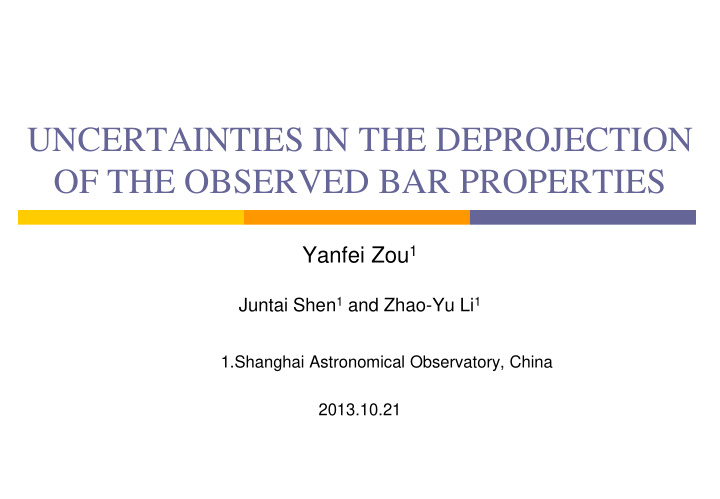



UNCERTAINTIES IN THE DEPROJECTION OF THE OBSERVED BAR PROPERTIES Yanfei Zou 1 Juntai Shen 1 and Zhao-Yu Li 1 1.Shanghai Astronomical Observatory, China 2013.10.21
MOTIVATION ~2/3 of disk galaxies are barred Composition of the bar old stars Bar pattern rotates rapidly Internal driver of disk galaxies gas inflow, central starburst, etc. energy and angular momentum exchange 2
MOTIVATION Deproject the inclined bar to face-on. Basic assumption of the deprojection The outer parts of the bar are vertically thin. Observed galaxies: projected 2D information 3
MOTIVATION Simulated galaxies: 3D information So we know the true face-on values of the bar length and ellipticity. Observe the simulated galaxy from different viewing angles The uncertainties of deprojection can be examined. 4
METHODS Data 3D information Model A Model B true face-on values of the bar length and ellipticity. Observe the simulated galaxies from different viewing angles 10 6 particles 2*10 6 particles We reduce the data rigid dark matter halo potential live halo in the same way as T = 1.8 Gyr T = 2.4 Gyr observations 5
METHODS Measure bar properties (length and ellipticity) IRAF ellipse fitting a max : Maximum ellipticity (Sheth et al. 2003) a min : Minimum ellipticity (Erwin 2005) a 10 : Position angle (PA) deviates by 10° (Erwin 2005) 6
METHODS Deproject bar properties to face-on 1-D analytical deprojection (Martin 1995) Assuming the bar is a straight line segment 2-D analytical deprojection (Gadotti et al. 2007) Assuming the bar is a planar elliptical structure 2-D image deprojection Other Fourier-based deprojections Fourier decomposition (Li Z-Y et al. 2011) 1. Deproject the image using GEOTRAN 2. Measure the deprojected bar properties Bar-interbar contrast 7 (Ohta et al. 1990)
RESULTS 2-D analytical deprojection of the bar length Assuming the bar is a planar elliptical structure The deviation of a dep /a int increases with the i The deprojected a max tends to overestimate the true face-on a max . There is no clear trend for a min and a 10 . i >60°, the deviation becomes large ~10% Φ bar 8
RESULTS 2-D analytical deprojection of the bar ellipticity A reflection of the strength of the bar The deviation of e dep /e int becomes large with i As Φ bar increases from 0° to 90°, the deprojected ellipticity gradually transition from under-estimate to over- estimate ~10% Φ bar 9
RESULTS Typical scatter in the deprojection 1D deprojection has the largest uncertainty ~20%. 2D deprojection is more accurate. The uncertainty is ~10%. Uncertainty of Fourier decompostion : ~5%. Bar-interbar contrast has large uncertainty, which is ~10%. 10
TOY MODEL Bar structure: triaxial ellipsoid shell. Axis ratio: a:b:h Project the shell of the triaxial ellipsoid from different i and Φ bar . 1D and 2D analytical deprojection are tested using this simple toy model 11
TOY MODEL 2D analytical deprojection of the toy bar length Uncertainties increase with i and Φ bar . Similar trend and scatter as the simulation results of 2D analytical deprojection. 12
TOY MODEL 2D analytical deprojection of the toy bar ellipticity Uncertainties increase with i. Deprojected ellipticity transition from under-estimate to over-estimate in the ellipticity deprojection as Φ bar increases from 0 ◦ to 90 ◦ . Similar trend and scatter as the simulation results of 2D analytical deprojection. 13
TOY MODEL Solid line: thick bar. Dashed line: 2D planar bar. Small residual at small i . Large residual at large i . Uncertainties mainly stem from the vertical structure of the bar. 14
SUMMARY Uncertainties of deprojection increase with i . All deprojection methods have trouble recovering the bar properties when i >60°. For a max , both the 1D and 2D methods overestimate the intrinsic bar length. There is no clear trend for a min and a 10 . As Φ bar increases from 0 ° to 90 °, the deprojected e max and e min from 2D methods transition from underestimate to overestimate. The deprojected e 10 is generally underestimated. Uncertainties of the deprojection can be reproduced by a simple toy model, which confirms that it mainly stems from the vertical structure of the bar. The uncertainty and application range of popular methods are given (lower limit). Provide guidelines for the sample selection and error estimation of future statistical research on barred galaxies. 15
Recommend
More recommend